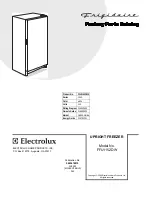
24
Before contacting After-sales Service…
Performance problems often result from little
things you can find and fix yourself without tools of
any kind.
Noises coming from your appliances are
normal since it has a number of fans and
engines to regulate performances that switch
on and off automatically.
Some of the functional noises can be reduced
through
-
Levelling the appliance and installing it on an
even surface
-
Separating and avoiding contact between the
appliance and furniture.
-
Checking if the internal components are
correctly placed.
-
Checking if bottles and containers are not in
contact with each other.
Some of the functional noises you might hear:
A hissing sound when switching on the
appliance for the first time or after a long
pause.
A gurgling sound when refrigerant fluid enters
into the pipes.
Buzzing sound when water valve or fan start
working.
A cracking sound when compressor starts or
when ready ice drops into ice box Abrupt
clicks when compressor switches on and off.
Automatic Ice maker noises (on some
models):
-
Since your appliance has an automatic ice maker,
you may hear buzzing (from the water valve),
trickling water and the clatter of the ice falling
into the bucket.
The appliance is not working:
• Is the power cable plugged into a live socket
with the proper voltage?
• Have you checked the protection devices and
fuses of the electrical system in your home?
If your automatic ice maker does not work (on
some models):
• Has the freezer had enough time to become
cold? With a new appliance this may take
overnight.
• Is the automatic ice maker ON/OFF button set
to ON?
• Make sure the lever of the automatic ice maker,
inside the freezer compartment, is not turned to
OFF, i.e. in the horizontal position (on some
models).
• Is the water turned on? Is water getting to the
automatic ice maker?
• Is there a water filter installed on the appliance
(on some models)? This filter may be clogged or
installed incorrectly. First, check the filter
installation instructions to ensure that the filter
was installed correctly and is not clogged. If
installation or clogging is not a problem, call a
qualified person or a technician.
If there is water in the defrost pan:
• This is normal in hot, damp weather. The pan
can even be half full. Make sure the appliance is
level so that the water does not overflow.
If the edges of the appliance cabinet, which
come in contact with the door seal, are warm
to the touch:
• This is normal in hot weather and when the
compressor is running.
If the light does not work:
• Have you checked the protection devices and
fuses of the electrical system in your home?
• Is the power cable plugged into a live socket
with the proper voltage?
• Has the light bulb burnt out?
In the case of burnt-out bulbs:
1.
Always unplug the appliance from the mains.
2.
See chapter "Maintenance and Cleaning".
If the motor seems to run too much:
• Is the condenser free of dust and fluff?
• Are the doors properly closed?
• Are the door seals properly fitted?
• On hot days or if the room is warm, the motor
naturally runs longer.
• If the appliance door has been left open for a
while or if large amounts of food have been
stored, the motor will run longer in order to
cool down the interior of the appliance.
• Motor running time depends on different things:
number of door openings, amount of food
stored, temperature of the room, setting of the
temperature controls.
If the appliance temperature is too high:
• Are the appliance controls correctly set?
• Has a large amount of food been added to the
appliance?
• Check that the doors are not opened too often.
• Check that the doors close properly.
• Make sure that air flow vents inside the
compartment are not blocked, as this prevents
the circulation of cold air.
TROUBLESHOOTING GUIDE






























